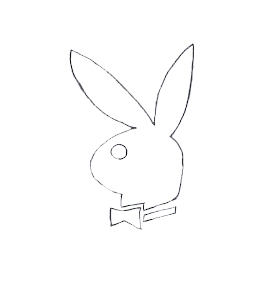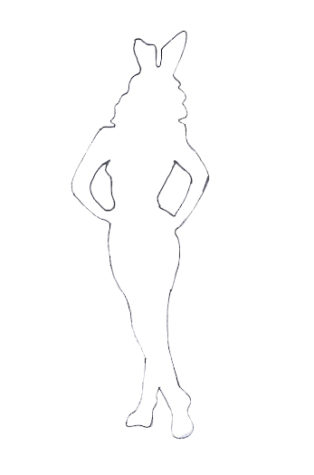Down the Rabbit Hole
How heartfelt are the progressive changes of the world’s original raunchy magazine? Sexism, years of exploitation
For the last 64 years, Playboy Enterprises has been branded by many as misogynistic for objectifying the women displayed on its sprawling pages, known as the Playboy Bunnies. Women pressured to satisfy the ideals of physical standards seem to serve a thinning number of people as the 21st century sets in.
Multiple former playmates, including Holly Madison who published “Down the Rabbit Hole,” retold their experiences in the Playboy Mansion and of the dark ongoings behind its tall, metal gates. Madison, who lived in the Mansion for seven years– at one point as Hugh Hefner’s number one girlfriend– collected many stories and opinions about the hidden practices she experienced in Hefner’s playground.
In October of this year, the magazine, which is a self-proclaimed supporter of equality, received both positive and negative publicity for featuring their first openly transgender playmate, Ines Rau. This caught the world’s attention, and has been used as a platform for equality by the LGBTQ community. The 26-year-old French model has since become a face of change in the Playboy world, displaying a fresh and empowering perspective of sexuality. However, it is yet to be determined if this new addition to the Playmate roster is enough to constitute a new direction for a company synonymous with pressured sex, misogyny and female dehumanization.

In 1953, using naked photos of Marilyn Monroe and $8,000 worth of donations, Hugh Hefner was able to produce the first Playboy issue out of his Chicago apartment. 54,000 copies were sold, and the magazine took off.
Hefner was a businessman and had claimed he was an advocate for civil rights, women’s rights and LGBTQ rights, straying away from the beliefs of his conservative, Methodist family. After publishing his first issue, Playboy Magazine consumed his everyday life from then until the day he died.
For over a decade the company grew and thrived, trademarking their infamous bunny logo along the way. It wasn’t until 1960 that Hefner bought the first Playboy Mansion, and the Playboy Bunny was born. After 60 years, the corporation has grown to become a multimillion dollar enterprise.
Some of the women deemed as Bunnies waitressed in Hefner’s clubs, a select group posed in the Playboy Magazine and the “lucky” few resided in the Playboy Mansion as one of Hefner’s many girlfriends.
Ironically, during the 1960s and growth of Playboy, the women’s rights movement, which also encompassed the “the sexual revolution,” was in full swing. Throughout the ‘60s as American women fought for equality, the birth control pill became a highly debated topic with Hugh Hefner being an outspoken advocate for the pill and sexual freedom among both men and women. Through Playboy Magazine, Hefner seemingly helped achieve that. The magazine issue diverged from the assumed social norms of the time, that saw intimacy and sexuality as something that went undiscussed; this aided in its rapid spread throughout the country and, later, the world.
The premature label of sexual liberation — as well as racial liberation — was attached to Hefner and his company. Hefner had no restrictions regarding what races could or couldn’t enter his clubs in the midst of de jure and de facto segregation across the United States. The first African American playmate, 20-year-old model Jennifer Jackson, also appeared in an issue in 1965 amongst heavy societal racial intolerance. The company received backlash for this seemingly bold decision, but stood by it. Similar negativity and judgement arose with the publishing of Ines Rau’s cover issue. In response to the hostility, Hugh Hefner’s son Cooper Hefner tweeted, “We should collectively be fighting for a more open world, not one that promotes hatred and a lack of acceptance.”
In addition to Playboy’s forward-looking proclamations displayed by risque content and advocating for racial equality, the brand has been alongside the LGBTQ rights movement. In 1991, the magazine featured their first transgender woman, Caroline Cossey. 26 years later, Playboy, specifically Hugh’s son Cooper, added Ines Rau as their first openly transgender playmate and centerfold bunny.
However, many people, especially women, focused on the darker side to
Playboy’s sexualization by interpreting its openness as exploitation rather than expression. Many thought, and still think, that although Hefner was an avid advocate for women’s reproductive rights and supported their ability to display themselves and their bodies, these encouragements came at the benefit of men; those who received the issues every month indulged in the physical appearances of the playmates rather than relishing in women’s newfound empowerment.
Although sexual emancpation for women is what Hefner so diligently preached, many pointed out his outright contradiction of that platform through the entire concept of his business and life. He promoted women being who they are and not being ashamed of their sexuality, but on the other hand he made the playmates in the mansion live by oppressive rules regarding their physical appearance and restricted them from dating any men other than himself. Hefner believed that everyone should be seen as equals when it comes to being sexual and intimate, yet by plastering women’s naked bodies on newsstands around the world for men’s satisfaction, he held them at their objective level.

The life of a Playboy bunny, which many women around the world envied, consisted of restrictive rules and unhealthy habits. With a curfew of 9 o’clock sharp, the bunnies couldn’t sleep away without permission or have any visitors visit the mansion— especially men. The women living in the mansion were each given free room and board and a $1,000 weekly allowance for clothes, shoes or anything else they wanted. Despite the exclusive criteria to become a Playmate and its seemingly dream-like benefits, it wasn’t always enough to make the Mansion what Hefner had desired.
“Hef would always use the occasion to bring up anything he wasn’t happy about in the relationship,” said said Izabella St. James in her book “Bunny Tales: Behind Closed Doors at the Playboy Mansion.” “Most of the complaints were about the lack of harmony among the girlfriends— or your lack of sexual participation in the ‘parties’ he held in his bedroom. If we’d been out of town for any reason and missed one of the official ‘going out’ nights [when Hefner liked to parade his girls at nightclubs] he wouldn’t want to give us the allowance. He used it as a weapon.”
The financial aspect of life at the mansion instilled an inferiority in the Playmates’ relationship with Hefner due to the fact that they were prohibited from having an outside job. In addition to allowance, the women were allowed to get their hair or nails done at any time and were expected to do so frequently; physical appearance was highly prioritized in Playboy and women were scrutinized if they didn’t meet the standards.
Hefner also funded all breast augmentations for those living in the mansion, as it was expected for all of the women to have this procedure. Many former Playmates later had their implants taken out after leaving the mansion.
All of the women were also required to partake in sexual intercourse with Hefner or other men at any time.
Unspoken competition between the Bunnies flared, and the women were left competing to be the skinniest, prettiest and Hefner’s favorite. This constant competition made, “the environment in the mansion toxic,” Madison said in “Down the Rabbit Hole.”
Though Hefner’s Playmate girlfriends who lived full time in the mansion with him received the most exploitation, it went beyond those boundaries into the horrors behind the sultry photos blown up on Playboy’s magazine spreads.
The same nude photos of Marilyn Monroe that were placed on the cover of Hefner’s first issue, were published without consent or even knowledge from Monroe. The photos had been taken years earlier by photographer Tom Kelley, before Monroe’s career took off, and later purchased by Hefner.
Actress and model Brooke Shields, now 52, was photographed and printed in a 1975 issue, showing Shields naked in a bathtub with heavy makeup on at the age of ten years old, landing her an over-sexualized reputation before she had even hit puberty.
Despite the company’s seemingly lewd and likely illegal business moves, Playboy, Hefner once said, “treat women— and men, too, for that matter— as sexual beings, not as sexual objects. In this sense, I think Playboy has been an effective force in the cause of female emancipation.”
But if female liberation was his true belief, many think that he should have embraced the idea that women, not just men, can be sexually active and expressive for their entire lives. However, through his choice of playmates, girlfriends and wives he exhibited that his idea of “liberation” only applied to a select group: tall, petite, young girls who constantly kept up their physical appearance. This disposable attitude towards women has made Playboy a nemesis of the feminist movement since the 70’s.
Following Hugh Hefner’s death, it is up to his will to determine who will receive part or all of his 35 percent share in Playboy Enterprises and 100 percent share in Playboy Magazine. Although it is unclear how it will be divided and to whom, Hefner’s 25-year-old son Cooper has assumed his father’s role as Chief Creative Officer for the company.
Cooper Hefner’s newfound control leaves the door open for the future of Playboy. Although Playboy currently does not have a strong presence in the media as it did three to four decades ago, the towering business continues its legacy as the original raunchy, risque magazine. Every year on October 31, young women and men hunt for a constricting black corset and bunny ears, or a replica of Hefner’s iconic red robe and pipe; this is likely a trend that will never fade. While these widely recognized symbols will be carried through generations of costumes and merchandise, the message behind Playboy may change over time, as seen with the hiring of Ines Rau. However, this addition to the Playmate crew does not automatically brand them as a platform for advocacy and empowerment. The absence of Playboy’s creator allows potential for the future of the company as a whole; however, the change in the message of the magazine, sparking ideas of LGBTQ representation in the media and the empowerment of women, may only be surface-level. Since his father’s death, Cooper Hefner has expressed interest in changing the way Playboy is perceived and, “recognizes his father’s intent, and he has a feeling for going about it as well— in his own way,” board member Dick Rosenzweig said. He plans to revive the nude aspect of the magazine in a more sophisticated way. Additionally, Cooper wants to use the nudity and the magazine overall as a promotion of women’s equality and a platform for their voice and opinions to be heard, a task in which many believed his father seemingly missed the mark.
It isn’t clear whether this is the route the company and magazine will take, however, Cooper’s first decision in his new position of power with the addition of Ines Rau, leaves many hopeful for a transformation. Until then, the exploitative and degrading history of Playboy Enterprises will continue to represent them; it is the future decisions that will determine how the company’s legacy will shape in the following decades in the hands of its new successor.







